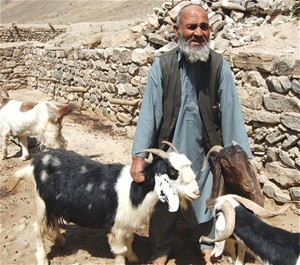Home » Reports & Data » Progress » Transforming Lives » Veterinary Care Saves Animals and Enriches Families

USAID's veterinary clinics helped this herdsman maintain a healthy flock of goats in Badakhshan.
USAID/David DeVoss
Veterinary clinics keep Badakhshan’s livestock alive and healthy.
4 APRIL 2009 | BADAKHSHAN PROVINCE, AFGHANISTAN
Animal husbandry is an unforgiving profession in Afghanistan. Economic survival depends on the number of sheep, goats, and cattle a family can sell each year. However, the lack of veterinary care in many areas leads to animal deaths, impoverishing families and endangering Afghanistan’s food supply. USAID-funded veterinary clinics are changing that by providing healthcare and vaccines to keep animals healthy.
In Badakhshan Province, many families depend on healthy livestock to make a living. In the summer, 1.8 million herd animals graze in the remote highland pastures and face constant threats from disease and parasites. It is common for a herdsman to lose nearly half of his flock by autumn.
Khodaar, a herdsman from the village of Sumdara, knows the problem well. “For years I’d build my flock to 100 animals only to lose 30 to 40 to disease,” he sighs. “Fifty goats will produce 30 to 40 kids if there’s no disease. But year after year I’d end up with 15 because the majority died.”
Today, animals are surviving at a much higher rate thanks to a USAID program that brings veterinary services to Afghanistan’s remote areas. In Badakhshan, USAID and the Dutch Committee for Afghanistan have trained nearly 200 veterinary workers to care for the region’s flocks and have constructed 35 veterinary field clinics. The clinics are supplied with medications, vaccines, and motorcycles which are used to reach outlying communities. Together, the animal healthcare workers vaccinate an average of 50,000 animals each month.
More serious animal health problems are addressed by the newly constructed Provincial Veterinary Center in Faizabad, which has modern laboratory and research facilities.
Sumdara’s veterinary worker has already made a difference in the lives of villagers and their livestock. This year, Khodaar’s goats stayed healthy, so he earned enough money to finish building a house and send his children to school. “I never was able to save a penny, because with fewer goats to sell, all the money I earned went to buy food for my eight children,” says Khodaar. “This year not a single animal died. Now when the children need pencils and notebooks, I can afford to buy them.”







Comment
Make a general inquiry or suggest an improvement.